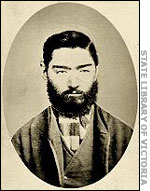- Home
- Shows
- Black Gold
- Body of Evidence
- Caribbean Cops
- Crisis Point
- Disorder in the Court
- Dominick Dunne's Power, Privilege and Justice
- Forensic Files
- Haunting Evidence
- Hot Pursuit
- Inside American Jail
- Videos
- Schedule
- Dumb Blog
- truTV Library
Ned Kelly
The Roots of Rebellion
To fully appreciate both the myth and the truth surrounding the Ned Kelly story, it is essential to understand the culture and the social conditions in which both were bred. According to documents compiled to by the Public Records Office of Victoria and made available through a comprehensive website on the Kelly gang called "Ned Online", Ned Kelly was born in 1853, the son of John Kelly, an Irishman who had been transported to Australia years earlier after being convicted of stealing a pair of pigs. Young Ned, the third of eight children, was by all accounts a bright, precocious and courageous youth.

Ned Kelly
There is one anecdote that indicates just how courageous a youngster he was, and it also gives a glimpse into the esteem in which his neighbors and friends in the rugged country around the settlement of Beveridge in Victoria held young Kelly.
According to published reports and local legend, Kelly was just 11 years old when he plucked a young neighbor boy named Dick Shelton from a roiling creek, saving the boy's life.
The boy's parents, Esau and Elizabeth Shelton, a moderately well-to-do couple by local standards were so grateful to young Ned that they rewarded him with a green silk fringed with gold. Kelly, it has been said, was so proud of the trophy that, years later, on the day he was captured outside the Glenrowan Inn, police removed his armored vest and found him wearing the now tattered sash.
But there is another side to the story of Ned Kelly's early years as well.
The struggling colonial outpost where Kelly was born was, in the middle of the 19th century, deeply divided along class lines. At the top of the social structure were those, who by dint of good fortune or a taste for adventure had pushed westward from New South Wales in the earliest days of the colony, staking out large tracts of grazing land for themselves. In time they had become rich, and powerful, and despite the graceless name by which they were known — Squatters — they had formed a kind of local aristocracy.
But, by the time Ned Kelly was born, new immigrants were already threatening their hegemony. Large numbers of new immigrants were moving into the area, some drawn by the promise of a new life on the frontier, others by the lure of quick riches during the Gold Rush of the 1850's. It fell to the new colonial government in Melbourne to device a scheme to find a way to accommodate both the newcomers and the well-entrenched squatters, and by the 1860's the government had come up with what it saw as a workable plan. It set aside tracts of land, none larger than 640 acres, which newcomers — dubbed selectors — could purchase at about a dollar and acre. Under the terms of the government contract, the selectors would pay for half of the land in advance, and would pay rent on the rest until it was paid off. In the meantime, they were required to make improvements on the land.
Though the idea seemed good on paper, it failed to take into account the harsh conditions in the bush. Dry spells followed torrential rains. Sandy topsoil took flight at the first sight of a plow. The land did not give up its bounty easily, often not at all, and soon, many settlers found themselves in much the same position as their ancestors in Ireland —destitute, hopeless, and living by the leave of far wealthier landlords.
It was perhaps as a result of the various Land Acts that many of the selectors stumbled across something that would grow in the unforgiving soil of northeastern Victoria — seething resentment and the kinds of crime that follow it.
It was against this backdrop that Ned Kelly came of age. He was, historians agree, just 12 years old when his father died, making Ned Kelly the man of the house. Unable to support themselves in Beveridge, the Kelly's moved deeper into the bush, to Eleven Mile Creek in the hardscrabble region known at Greta.



- The Man in the Metal Mask
- The Enigma Behind the Mask
- The Roots of Rebellion
- A Small-Time Crook
- First Conviction
- A Beggar on Horseback
- Home
- A Shot in the Dark
- The Temperature Rises
- Showdown at String Bark Creek
- Recasting the Rebellion
- First Draft of History
- Jerilderie
- Desperate Times
- Suits of Armor
- Last Stand
- The Verdict of History
- Bibliography

Join a conversation:

- » Robert Ackermann: Teen Cannibal
- » When Children Kill
- » More Horrors Revealed in Dungeon Dad Case
- » The Caylee Anthony Story -- Part One
- » The Peterson Evidence Photo Gallery
- » When Cheerleaders Hit Rock Bottom
- » Mistaken Myspace Suicide: The Megan Meier Case
- » The Woodchipper Murder Case
- » Kristin Rossum: The Rose Petal Murder
- » Porn Stars Who Fought the Law









